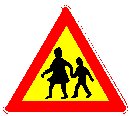Walking in Traffic: What I Need to Know and Teach my ChildrenChildren should follow these important road safety rules when walking in traffic to keep safe
|
| STOP | before I step on to the road |
| LOOK | right, left, then check back to my right again for traffic |
| LISTEN | for oncoming traffic I may not be able to see |
| THINK | safety Ė I must make sure the break in traffic gives me enough time to cross safely |
-
I must never run because I might fall and get run over by a vehicle
-
I must never try to cross the road in between parked vehicles because the drivers of oncoming vehicles may not be able to see
I MUST REMEMBER ALWAYS
That I see and am seen
-
Drivers need to see you to avoid knocking into you
-
Stay out of the driver's blind spot
-
Make eye contact with drivers when crossing busy streets
-
Try to wear reflective clothing if you are walking near traffic at night. Carry a flashlight when walking in the dark.
Parents, watch your kids
-
Young children should not cross streets by themselves or be allowed to play or walk near traffic. They are only unpredictable but are not capable of judging vehicle distances and speeds
-
When children get older, teach them three things to do before they cross a street: (1) Cross at traffic lights (2) Stop at the kerb (3) Then look left, right, and left again before crossing
-
Hold your childís hand and position him or her on the side of you that is away from traffic. Insist that older children remain by your side and do not race on ahead
-
Set a good example as children generally copy what you do and not what you tell them. Do not jaywalk and cross only at safe crossing points. Do not call out to your children to come to you from the other side of the road
-
Use every walking trip as a teaching opportunity. Talk to your children about what you are doing and explain the reasons for your actions. Give them the opportunity to tell you whether they feel it is safe to cross but donít let them do it on their own until you are absolutely sure that they are ready
-
Remember that because children are much shorter than you, they may not be able to see what you are doing
-
Donít let your children play on roads Ė not even on quiet residential streets
![]()
 Walk
on the Sidewalk
Walk
on the Sidewalk designated crosswalks
designated crosswalks